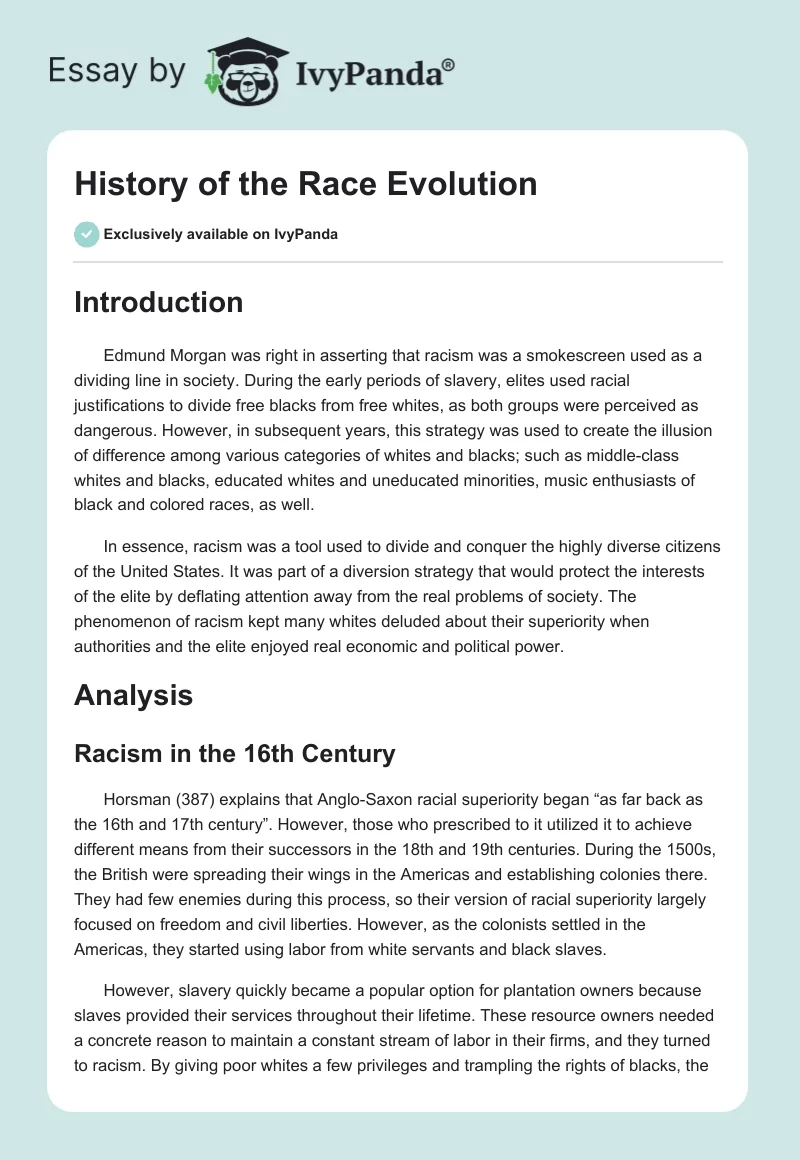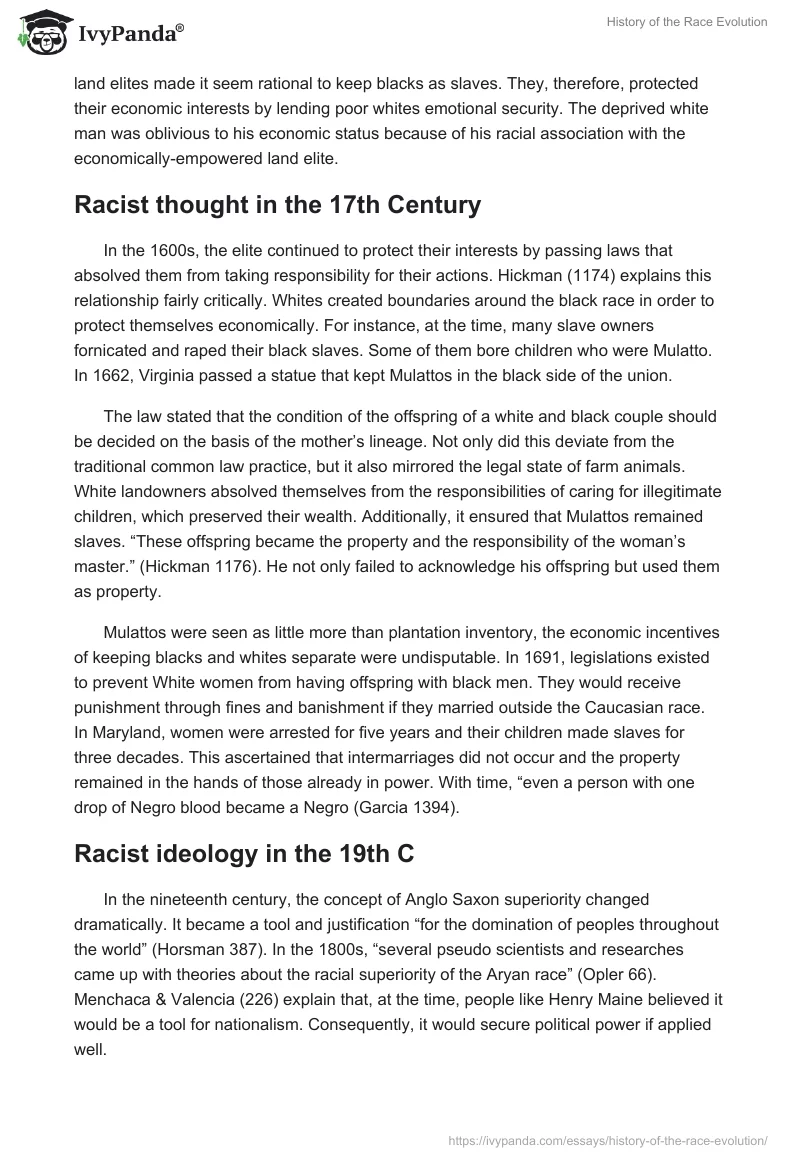Introduction
Edmund Morgan was right in asserting that racism was a smokescreen used as a dividing line in society. During the early periods of slavery, elites used racial justifications to divide free blacks from free whites, as both groups were perceived as dangerous. However, in subsequent years, this strategy was used to create the illusion of difference among various categories of whites and blacks; such as middle-class whites and blacks, educated whites and uneducated minorities, music enthusiasts of black and colored races, as well.
In essence, racism was a tool used to divide and conquer the highly diverse citizens of the United States. It was part of a diversion strategy that would protect the interests of the elite by deflating attention away from the real problems of society. The phenomenon of racism kept many whites deluded about their superiority when authorities and the elite enjoyed real economic and political power.
Analysis
Racism in the 16th Century
Horsman (387) explains that Anglo-Saxon racial superiority began “as far back as the 16th and 17th century”. However, those who prescribed to it utilized it to achieve different means from their successors in the 18th and 19th centuries. During the 1500s, the British were spreading their wings in the Americas and establishing colonies there. They had few enemies during this process, so their version of racial superiority largely focused on freedom and civil liberties. However, as the colonists settled in the Americas, they started using labor from white servants and black slaves.
However, slavery quickly became a popular option for plantation owners because slaves provided their services throughout their lifetime. These resource owners needed a concrete reason to maintain a constant stream of labor in their firms, and they turned to racism. By giving poor whites a few privileges and trampling the rights of blacks, the land elites made it seem rational to keep blacks as slaves. They, therefore, protected their economic interests by lending poor whites emotional security. The deprived white man was oblivious to his economic status because of his racial association with the economically-empowered land elite.
Racist thought in the 17th Century
In the 1600s, the elite continued to protect their interests by passing laws that absolved them from taking responsibility for their actions. Hickman (1174) explains this relationship fairly critically. Whites created boundaries around the black race in order to protect themselves economically. For instance, at the time, many slave owners fornicated and raped their black slaves. Some of them bore children who were Mulatto. In 1662, Virginia passed a statue that kept Mulattos in the black side of the union.
The law stated that the condition of the offspring of a white and black couple should be decided on the basis of the mother’s lineage. Not only did this deviate from the traditional common law practice, but it also mirrored the legal state of farm animals. White landowners absolved themselves from the responsibilities of caring for illegitimate children, which preserved their wealth. Additionally, it ensured that Mulattos remained slaves. “These offspring became the property and the responsibility of the woman’s master.” (Hickman 1176). He not only failed to acknowledge his offspring but used them as property.
Mulattos were seen as little more than plantation inventory, the economic incentives of keeping blacks and whites separate were undisputable. In 1691, legislations existed to prevent White women from having offspring with black men. They would receive punishment through fines and banishment if they married outside the Caucasian race. In Maryland, women were arrested for five years and their children made slaves for three decades. This ascertained that intermarriages did not occur and the property remained in the hands of those already in power. With time, “even a person with one drop of Negro blood became a Negro (Garcia 1394).
Racist ideology in the 19th C
In the nineteenth century, the concept of Anglo Saxon superiority changed dramatically. It became a tool and justification “for the domination of peoples throughout the world” (Horsman 387). In the 1800s, “several pseudo scientists and researches came up with theories about the racial superiority of the Aryan race” (Opler 66). Menchaca & Valencia (226) explain that, at the time, people like Henry Maine believed it would be a tool for nationalism. Consequently, it would secure political power if applied well.
These beliefs in the racial superiority of white people spread into different facets of American life, such as religion and government. In religious circles, many clergymen taught that it was God’s plan to ensure that whites conquered inferior races, as they were not Christian. In essence, this gave the church power to discriminate against black or minority groups. Their teachings caused several white-only churches to flourish. Expansionist wars against neighboring groups, such as the Mexican war, were justified on the basis of these ideologies.
The authorities won the support of their people during the war because they had convinced them that it was God’s plan for the US to triumph over other faiths. Menchaca & Valencia (228) add that “The Latinos defeat in the Mexican and Spanish wars was reviewed to be evidence of their half-breed inferiority”. Consequently, these justifications echo Edmund Morgan’s sentiments that racism was a smokescreen. It protected the position of those in authority by rationalizing their selfish actions.
During the 1800s, the US government passed several legislations designed to maintain the status quo. At the time, the country adopted separate but equal legislation, in which whites and blacks were to live in separate communities. The consequence of such policies was the provision of substandard education to racial minorities. It also ensured that black and other colored people remained landless and economically disempowered. This would solidify landowners’ positions. By the late 1800s, many locations within the US were a preserve for racial minorities.
Anglo-Americans prohibited individuals from moving into predominantly white locations. Through harassment and violence, coloreds were designated to certain parts of the country. The elite protected their interests by ensuring that a growing number of racial minorities remained disenfranchised. Rutledge (249) states that “the need to subjugate speaks volumes about the tangible political and economic gains accrued to those doing the subjugating.” Racism was a moral justification for actions that contradict the democratic principles of the racists.
Early 20th Century racial discrimination
In the 1900s, a number of scholars started to challenge racial superiority ideologies. They realized that previous intelligence tests and assertions about the superiority of the white race were not scientifically-based. Wallis (313) believed that “although accomplishments differed among the races, many of these differences altered with time.” He asserted that the psychological capabilities of the white race or ‘failures’ of other races occurred on the basis of historical opportunities. Racial potentialities were regarded as equal.
These scholars questioned the nature of evidence concerning racial differences. Many psychological tests indicated that differences existed between persons of the European race yet no attribution was made to their physical appearance. Additionally, the performance was compounded by one’s social opportunities. Although blacks’ ratings were lower than their white counterparts, their performance depended upon their location. Consequently, their accomplishments had little to do with their race but with their opportunities.
These thoughts minimized the use of intellectual superiority as an excuse for racial discrimination. However, the elite came up with other excuses for segregation. For instance, they claimed that members of minority groups were dirty and lacked social etiquette (Menchaca & Valencia 230). Consequently, they started using cultural factors as a basis for segregation. The 1920s were a time when blacks and coloreds could not use the same restaurants, schools, theaters or pools as Anglo-Americans. Separate-but-equal legislation continued to thrive in many parts of the country. Schools for minorities existed alongside exclusively white schools. The authorities maintained that Mexicans had separate language needs, which would best be met through separate schools.
However, these were smokescreens designed to cover racist attitudes. When one analyses the reason behind segregation in the early 20th century, one can see that it supports Edmund Morgan’s assertions about racism as a tool. Segregation in social spheres, especially in education, minimized black people’s access to equal economic opportunities. This ensured that the privileged class would always have access to cheap and flexible labor (Menchaca & Valencia 223). School segregation, in particular, ensured that a caste-like system would be solidified in American society. It minimized the life chances and the opportunities available to racial minorities thus ascertaining that the elite maintained their positions of power.
Macias (696) explains that the situation did not change dramatically even in the 1940s. Segregation was still rife in social scenes around the country. At the time, different versions of music emanated from racial minority groups such as Latinos and African Americans. In fact, plenty of white patrons would frequent predominantly black or Latino clubs in order to get a taste of their music. However, authorities did not want members of all races to interact. Consequently, they passed laws that prohibited the sale of alcohol after a certain time in order to minimize interactions. As Macias (693) says, “popular music and dance performances provoked reactionary regulation by the established authorities”.
They created music bureaus designed to promote ‘white’ music. They also labeled jazz and other minority-based forms of expression as improper or primitive. If left uncontrolled, this continued mixing would result in tolerance and respect towards members of other races. Persons in authority needed to keep the cultures of colored people separate from Anglo-Americans to maintain boundaries between them. This division would create the impression that whites owed allegiance to all things white include their cultural expressions as well as their political choices. Therefore, racism, as expressed in the realm of music, was a screen intended on protecting the authorities’ political power.
Conclusion
A history of the evolution of racial law in the US illustrates that Edmund Morgan’s claim was true; racial contempt was a screen used to cover the divisive and selfish interests of the elite. At first, they applied it to indentured servants and slaves to prevent a Bacon rebellion. The elite then did it to create an illusion of power among whites in order to safeguard slave labor for themselves. Racism was further used to keep racial minorities landless. Segregation became rife in order to maintain political power through elevation of the privileges of the white race, which would remain loyal to white authorities. Racism, therefore, was an instrument for maintaining political and economic power among the elite.
Works Cited
Garcia, Richard. “The Misuse of Race in Medical Diagnosis.” Paediatrics 113.5(2004): 1394-1395. Print.
Hickman, Christine. “The Devil and the One Drop Rule: Racial Categories, African Americans, and the U.S. Census.” Michigan Law Review 95.5 (1997): 1161-1265. Print.
Horsman, Reginald. “The Origins of Racial Anglo-Saxonism in Great Britain Before 1850,” Journal of the History of Ideas 37.3(1976): 387-389. Print.
Macias, Anthony. “Bringing Music to the People: Race, Urban Culture, and Municipal Politics in Postwar Los Angeles.” American Quarterly 56.3(2004): 693-717. Print.
Menchaca, Martha and Richard Valencia. “Anglo-Saxon Ideologies in the 1920s-1930s: The Impact on the Segregation of Mexican Students in California.” Anthropology & Education Quarterly 21.3(1990): 222-249. Print.
Opler, Morris. “The Bio-Social Basis of Thought in the Third Reich.” American Sociological Review 10.6(1945): 66. Print.
Rutledge, Dennis, “Social Darwinism, Scientific Racism, and the Metaphysics of Race.” Journal of Negro Education 64.3(1995): 243-252. Print.
Wallis, Wilson. “Race and Culture.” The Scientific Monthly 23.4(1926): 313. Print.


